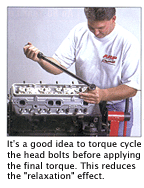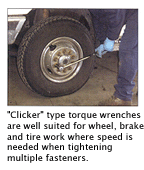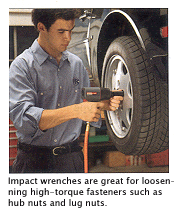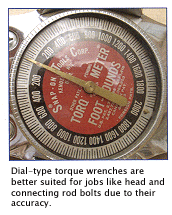Torque is what holds the automotive world together and keeps things from falling apart (with the help of friction). Anytime you tighten a nut, bolt or screw, you are applying torque through a wrench, ratchet handle, nutdriver or screwdriver. The harder you push, pull or twist the tool, the greater the torque you apply to the fastener. But if you use too much muscle, you may strip the threads or break the fastener. And if you don’t get the fastener tight enough, it might not hold the parts together properly or they may come loose. In other words, you use torque to make sure fasteners are tight, but not too tight.
Torque Explained
Basically, torque is force times distance. It’s the amount of rotating or twisting force that is created by applying a force perpendicular to an axis. The distance from the axis that the force is applied multiplies the force. In plain English, the longer the wrench, the greater the applied force with the same amount of effort.
 Take, for example, that you attach a 1″ socket to a foot-long ratchet wrench and slip the socket over the axle nut on a FWD car, the force applied to loosen the nut will depend on how hard you lean on the bar. You pull really hard and exert 100 lbs. of force on the wrench, but you fail to break the nut loose. The only thing you break is a sweat. Time to grab a bigger wrench.
Take, for example, that you attach a 1″ socket to a foot-long ratchet wrench and slip the socket over the axle nut on a FWD car, the force applied to loosen the nut will depend on how hard you lean on the bar. You pull really hard and exert 100 lbs. of force on the wrench, but you fail to break the nut loose. The only thing you break is a sweat. Time to grab a bigger wrench.
So then you attach a 2′-long breaker bar to the socket and try again. Now the same 100 lbs. of force you’re exerting on the wrench is doubled because you have doubled the length of the wrench. The torque applied to the nut is now 200 ft.-lbs., but it still doesn’t break loose. Your face is turning red, along with your language. You need an even bigger wrench. You slip a 4′-long hollow steel pipe over the breaker bar handle. Your “cheater bar” now quadruples your effort. A 100-lb. pull now generates 400 lbs. of torque at the nut – and presto, the nut finally breaks loose!
Meanwhile, your buddy in the next service bay says, “Why didn’t you just use an impact wrench to bust the nut loose? It’s a lot easier, and safer, too.” You know what? He’s right. A pneumatic impact wrench can generate just as much force as a cheater bar with virtually no effort on your part. It uses compressed air to spin a motor. The motor’s torque output is multiplied three to six times by a planetary gear set. When a certain limit is reached, a spring-loaded hammer begins to pound against an anvil attached to the impact wrench’s output shaft. The motor continues to hammer away, exerting torque on the socket until the fastener finally breaks loose and starts to turn.
 Impact wrenches are great for loosening high-torque fasteners, such as hub nuts and lug nuts and also rusty bolts like those on exhaust manifolds, shock absorbers, struts and other steering and suspension parts. There’s also no “torque reaction” or kick-back to worry about if you’re using an impact wrench. When the fastener finally breaks loose, there’s no wrench handle to suddenly slip forward and bust your knuckles against the fender or some other object. Using an impact wrench also reduces the risk of breaking a stubborn fastener. So save your back and knuckles by using an impact wrench to loosen high-torque fasteners.
Impact wrenches are great for loosening high-torque fasteners, such as hub nuts and lug nuts and also rusty bolts like those on exhaust manifolds, shock absorbers, struts and other steering and suspension parts. There’s also no “torque reaction” or kick-back to worry about if you’re using an impact wrench. When the fastener finally breaks loose, there’s no wrench handle to suddenly slip forward and bust your knuckles against the fender or some other object. Using an impact wrench also reduces the risk of breaking a stubborn fastener. So save your back and knuckles by using an impact wrench to loosen high-torque fasteners.
Tightening Troubles
Don’t use an impact wrench to tighten critical fasteners, such as lug nuts, head bolts, main bearing caps and so on. They must be tightened to a specific torque value for different reasons. With lug nuts, wheel retention is the main issue. If the lug nuts are not tight enough, the wheel may come off the vehicle. If the lug nuts are too tight or not all tightened to the same value, it can distort the hub and rotor causing the rotor to wear unevenly and develop a brake pedal pulsation over time.
 With head bolts, the torque on the bolts determines the amount of clamping force and crush on the gasket. It also affects head loading and cylinder bore distortion. Many late-model engines have “torque-to-yield” (TTY) head bolts that are tightened to a certain value, then given so many degrees of twist to stretch the bolt (which requires the use of an additional angle gauge). Stretching the bolt to the yield point evens out the clamping load around the cylinders so the head gasket will seal properly.
With head bolts, the torque on the bolts determines the amount of clamping force and crush on the gasket. It also affects head loading and cylinder bore distortion. Many late-model engines have “torque-to-yield” (TTY) head bolts that are tightened to a certain value, then given so many degrees of twist to stretch the bolt (which requires the use of an additional angle gauge). Stretching the bolt to the yield point evens out the clamping load around the cylinders so the head gasket will seal properly.
Even non-critical fasteners, such as intake manifold bolts and bolts on valve covers and oil pans, may have a specified torque value. Plastic intake manifolds can be easily cracked if the mounting or attaching bolts are overtightened. Stamped steel components can also be deformed or gaskets crushed if fasteners are overtightened. Even parts such as spark plugs that screw into aluminum cylinder heads, oxygen sensors and other sensors may have recommended torque values to prevent thread or component damage during installation.
 Overtightening or undertightening fasteners can cause major problems, so it’s important to use some type of tool that can accurately measure the amount of torque that is being applied to a fastener. An ordinary impact wrench may have some level of force adjustment, but the range of adjustment is not calibrated and certainly isn’t accurate enough to achieve the level of precision required for many fasteners today.
Overtightening or undertightening fasteners can cause major problems, so it’s important to use some type of tool that can accurately measure the amount of torque that is being applied to a fastener. An ordinary impact wrench may have some level of force adjustment, but the range of adjustment is not calibrated and certainly isn’t accurate enough to achieve the level of precision required for many fasteners today.
Even with tons of experience, you can’t accurately “feel” how much torque is right for a particular fastener. Close enough is not good enough with critical fasteners or even many non-critical fasteners. What you need is a torque wrench.
What’s Your Type
Torque wrenches are available in various styles. The simplest and least expensive version is a “beam-style” torque wrench. You’ll find them in the automotive section of many hardware stores, as well as DIY tool racks in automotive parts stores. This type of tool has a long pointer beam that runs parallel to the handle shaft. When you apply force on the handle, the handle deflects, but the pointer remains straight to indicate how much torque is being applied. The pointer scale typically has calibration marks every 5 lbs. (on a ft.-lbs. scale). To read the scale accurately, you must look at it straight on. You may also have to “estimate” the actual reading if the pointer is between lines. Provided the tool isn’t abused or damaged, it should remain accurate almost indefinitely.
Another style is the “dial indicator” torque wrench. On this tool, the beam is enclosed in a housing and operates a dial indicator to show how much torque is being applied. The dial indicator is more precise and is easier to read. Some are available with a light or buzzer to indicate when a preset torque value is achieved.
There are also digital versions of the dial indictor torque wrench. Instead of a mechanical analog gauge, a LCD or LED display shows the exact torque value. Most digital wrenches also offer the capability to switch from SAE to metric units of measurement.
Another popular style is the “micrometer” or “click-style” torque wrench. With this design, the tool makes an audible click to let you know when a certain torque level has been achieved. Inside the handle is a compression spring that exerts pressure against a lever held against a notch. The tool is adjusted by turning a threaded adjuster sleeve on the handle. When the desired level of torque is achieved, the lever jumps from the notch and makes a click – which you can also feel in the handle. Many technicians prefer this type of tool because it’s fast and easy to use. You just pull on the handle until you hear or feel it click, then move on to the next fastener.
One thing to keep in mind about adjustable click-style torque wrenches is that you should always reset them back to zero after use. If a torque wrench is put away with the value set to a high reading, it can affect the accuracy of the compression spring over time, causing the tool to go out of calibration.
One item that is a “must have” with all types of mechanical torque wrenches is an “angle gauge.” This is a small metal or plastic wheel that mounts on the socket or tool drive to tell you how far around the wrench handle is being pulled from a particular point. The idea behind angle torquing fasteners is to eliminate variables in torque caused by dirty or damaged bolt threads. With this method, the fastener is usually tightened to a low value, then turned an additional number of degrees to achieve final loading.
The Issue of Accuracy
One of the problems encountered with any tool or instrument that is calibrated to a specific standard is that it may go out of calibration over time or as a result of misuse. Torque wrenches are no exception. A simple beam-style torque wrench is pretty reliable, but it’s not as accurate as the dial- or click-type torque wrenches. If you drop a beam-style torque wrench and bend the pointer or scale, it obviously won’t read accurately. You can try to bend things back to their original position, but you may or may not succeed in restoring the tool’s accuracy.
The same goes for all the other types of torque wrenches. They are not designed to take a lot of abuse. Dropping the tool may knock it out of calibration. Misusing the tool can also affect its calibration. Never use a cheater bar on a torque wrench. Most experts also advise against using a torque wrench to break loose fasteners because the sudden shock when the fastener breaks free may affect calibration.
Most experts say torque wrenches should be checked and recalibrated every six to 12 months depending on use. The more frequently the tool is used, the more often it should be checked to make sure it’s properly calibrated.
Electronic Torque Gauges and Instruments
One way around the calibration issue with mechanical torque wrenches is to use some type of electronic torque meter or sensor. Most use a sensitive pressure transducer to measure the amount of force being applied to a fastener. It’s the same technology tool manufacturers use to calibrate mechanical click-style torque wrenches at the factory and in the field.
Electronic torque gauges are said to be four to eight times more accurate than conventional mechanical torque wrenches. For everyday use, you many not need such a high degree of precision. But some people do. Engine builders who are involved in motorsports or aviation often want the best that’s available. The same goes for diesel engine builders who must be able to guarantee long-term durability (one comeback can cost them a small fortune).
Some of these electronic units are handheld instruments with a transducer that attaches to a socket or extension to sense torque. Others allow a standard digital multimeter to be converted into a torque meter by coupling the meter to a torque-sensing transducer. One such tool comes with a torque module interface that plugs into a digital multimeter and a choice of three different transducers (1/4″, 3/8″ and 1/2″ square drive).
Electronic torque meters offer several benefits in addition to improved accuracy. The large digital displays are easier to read. They can also be used in tight spots where a conventional torque wrench may not work. The transducer is not affected by the use of extensions or swivels as long as it remains attached to the socket on the fastener. Some industrial models also allow torque data to be collected, stored and printed out if documentation is required to prove an engine or other component was correctly assembled.
For Those Techs With Really Deep Pockets
There also are high-tech computerized torque wrenches for super accurate work. These tools bring the accuracy of a lab instrument into the shop environment. The main advantages of this type of tool (besides impressing your friends and customers) is that it can also be used to check the torque on fasteners that have been previously tightened without the need to loosen and retighten the fasteners. In other words, you can use the tool to double-check your work or the work of others. Some engine builders use this type of tool to recheck all critical fasteners before any work leaves the shop.
A computerized torque wrench can also monitor and display angle in degrees when tightening bolts with angle specifications. This type of tool eliminates the need for using a stretch gauge to check connecting rod bolts. It also has built-in self-diagnostics to verify it’s working properly and is accurately calibrated.
Torque Sticks
Now that you know how important accurate torque is on critical fasteners, we should mention another type of tool that makes accurate torque readings easier to achieve. Busy technicians in tire dealerships don’t always use a torque wrench to final tighten lug nuts when mounting wheels. They should, because torque is especially important with alloy wheels. And, as we said earlier, it can affect disc brake rotors, too. But some techs may skip this final step because it takes too much time, or they can’t find the torque wrench or maybe they don’t even own a torque wrench.
An alternative solution for this type of application is to use “torque-sensing sticks” with an impact wrench to tighten the lug nuts. These tools resemble an ordinary socket with a long extension. The length and thickness of the specially heat-treated spring steel tool shaft give it a certain amount of flexibility that automatically limits the maximum amount of torque that can be applied by an impact wrench. It sounds impossible, but it works.
One manufacturer says their torque sticks can accurately limit torque to within plus or minus 5% of a specified value. Evaluation tests conducted by General Motors found that accuracy was actually even better – within plus or minus 2%!
When the desired torque range is achieved, the shaft of the torque stick begins to flex in sync with the blows of the impact wrench preventing it from overtightening the lug nut. The torque sticks may be color coded so you know which one to use with which application.





